A faint constellation in the northern sky with no brighter stars. It is located north of the constellations of Cancer and Gemini. It is largely circumpolar in our latitudes, with only the southern parts falling below the horizon. The brightest star is α Lynx, which reaches 3mag. It is easy to find, forming a fairly large, almost equilateral triangle with the stars Pollux and Regulus. This is followed by 38 Lynx and 12 others brighter than 5mag. From an astronomical point of view, the constellation is one of the less interesting ones. It does not contain open clusters and nebulae. Only a few binaries, faint galaxies and one interesting distant globular cluster, the Intergalactic Wanderer, are worth mentioning.
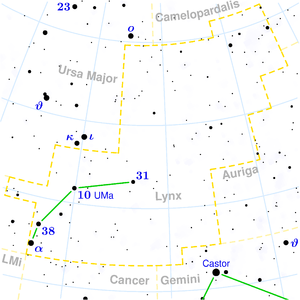
38 Lyn - The binary star is located approximately on the border with the neighboring constellation of Leo Minor. The main white component has a brightness of 3.9 mag, the red companion has a brightness of 6.6 mag. They are mutually separated by 2.7" and their distance from Earth is about 117 light years. The main star has about 32 times the luminosity of the Sun. At a distance of about 88" from this star, we can see another companion with a stellar magnitude of 11 mag, which, however, is only coincidentally projected into this area. It is advisable to use at least 100x magnification.
12 Lyn - A physical binary star composed of relatively equally bright components - 5.4mag and 6mag. They are separated by 1.8" and their orbital period is 907 years. At a distance of about 8.5" from the brighter component, there is another companion with a brightness of 7.5mag.
5 Lyn - The asterism, even in a smaller telescope, is a nice, wide pair of yellow 5.3 magnitude and blue 9.8 magnitude components, which are separated by 31.4". The third component, with a magnitude of 7.9, is separated by 96". Nearby, there is the double star 6 Lyn and two other wide pairs. The one located one degree northeast of 5 Lyn is composed of an orange and blue component, while the second one consists of two white components.
19 Lyn - This optical binary star can be easily distinguished even with a small telescope. Both stars, one with a brightness of 5.6 mag and the other with 6.5 mag, are separated by 14.8". The first one has a yellow-white color, while the second one has a light blue color. The light from the first star travels 680 light-years to reach us, while the light from the second star travels 690 light-years. In a larger telescope, two more optically associated companions can be observed.
NGC 2419
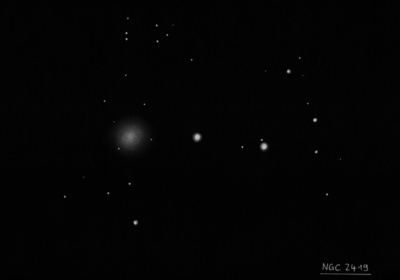
William Herschel discovered NGC 2419 = H I-218 = h457 on 31 Dec 1788 (sweep 901) and wrote "cB, R, vgmbM, about 3' diameter." John Herschel described the globular on 18 Mar 1831(sweep 335) as "not vB; L; pmE in parallel; 2' l and 75" br." This is an interesting observation as the globular is generally described as round. The first time it was logged at Birr Castle on 9 Mar 1850, Lord Rosse remarked "I think clearly resolved, several points, at least 3 seen plainly in edge which I suspect to be filamentous; no nucl., more round than h[erschel] describes it." The 13 Feb 1852 observation even notes "Lord Rosse thought it like a cluster at a great distance."
NGC 2419 was shown to be globular cluster in 1922 on a plate taken at Lowell Observatory. Shapley estimated a distance of 160,000 l.y. (current estimate ~275,000 l.y., nearly twice the distance of the LMC) and along with Sawyer, assigned it concentration class II. He may have been the first to use the nickname "Intergalactic Tramp" in the 1944 paper "Revision of the Distances of 30 high-latitude Globular Clusters."
200/250mm - 8" very faint, small, round, no resolution. Collinear with two mag 8 stars to the west and a mag 9 star in the field W.
400/500mm - 17.5" (3/20/93): fairly faint, round, 2' diameter, gradually brighter core but no well-defined nucleus, mottled appearance although no resolution into stars. Framed by a quadrilateral of four mag 13-14 stars and a few other faint stars. Collinear with mag 7.0 SAO 60232 4' W and mag 7.9 SAO 60229 8' W. The "Intergalactic Tramp" is one of most distant globulars from earth and may be the core of an accreted dwarf galaxy.
Notes by Steve Gottlieb
NGC 2683
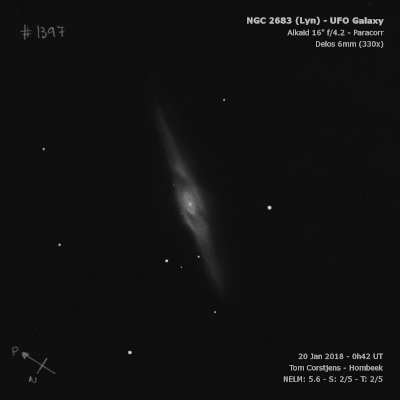
William Herschel discovered NGC 2683 = H I-200 = h532 on 5 Feb 1788 (sweep 807) and reported "very brilliant, mE from sp to nf but nearer the meridian, about 7 or 8' l and 2 1/2 or 3' br. The brightness also much elongated and going off pretty suddently; a beautiful object." A total of 16 observations were made at Birr Castle and several times it was described as slightly concave and sharper on the preceding side. On 2 Jan 1868, "vF streaks and lanes on each side parallel to ray [were suspected]."
300/350mm - 13.1" (1/18/85): very bright, very large, nearly edge-on 4:1 SW-NE, 8.0'x2.0', halo is broadly concentrated. Mottled or dusty near the core but no distinct nucleus.
16x80 (1/18/85): visible in finder as a faint, edge-on steak
13.1" (2/25/84): bright and impressive, brigter core, thin fainter extensions oriented SW-NE.
400/500mm - 18" (3/13/10): gorgeous view at 280x! This detailed, edge-on spiral extends 9'x1.5' SW-NE. The central region is well concentrated with a very bright, elongated core, roughly 3'x1.5' and noticeably mottled or dusty with brighter knots or spots near the core. The southwest extension is more prominent and was easily traced to the outer tip. It broadly increased in brightness to the core. In contrast, the northeast extension faded rapidly after the core. The northeast arm had a low surface brightness as it extended past a mag 13 star (close double) off the north flank. Overall, the galaxy presents an unusual warped appearance with the southwest and northeast extensions not aligned in position angle.
Notes by Steve Gottlieb
NGC 2537
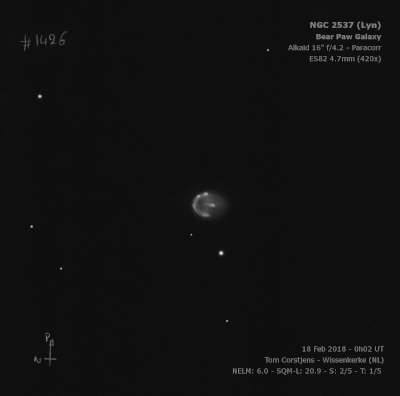
William Herschel discovered NGC 2537 = H IV-55 = h491 on 6 Feb 1788 (sweep 809) and recorded "pB; R; pL; preceding a star about 1'." On 10 Mar 1788 (sweep 817) he logged "pB, R, almost of an even light througout, approaching to a planetary [he placed it in the category of planetary nebulae] but very ill defined, and a little fainter on the edges, about 3/4 or 1' dia." John Herschel observed the galaxy on 19 Mar 1828 (sweep 139) and remarked, "It is a globular cluster. Being a remarkable fine night, I see the stars." NGC 2537 was observed 20 times at Birr Castle and even noted as "probably spiral" in Jan 1852, although photographs show no significant spirality. Other observations refer to its resolvability and the GC and NGC description call it a globular cluster! When it was photographed at Lick Observatory with the Crossley reflector, Curtis noted (1918), "This is not a cluster, as described in the NGC, but a bright, irregular spiral." Francis Peases desribed it as a "horseshoe" based on a photograph with the 60" at Mt. Wilson, and mentions a "faint spot" nearby to the east, which is the companion galaxy NGC 2537A.
Wolfgang Steinicke reports that the nickname is from Ron Buta, based on an observation through a 36" telescope at McDonald 36" (Webb Society Galaxy Handbook, 1981): "Small and of relatively high surface brightness; shaped like a bear-paw, the structure consisting of a single spiral arm winding from W to E around the N side; this ring-tail includes 3 knots, one of about 15 mag; a bar-like feature shows in the interior region of the arm and extends to the S edge of the galaxy; there is a faint glow between the arm and the bar feature".
300/350mm - 13.1" (2/25/84): fairly faint, small, round, no structure.
400/500mm - 17.5" (3/23/85): moderately bright, fairly small, round. The "Bear-paw" galaxy has an unusual appearance with a dark lane or vacuity in the center. A small slightly brighter knot is visible along the NW edge. A mag 11 star is 2' SE. Located 6.5' E of mag 8.4 SAO 42225. IC 2233, a faint edge-on, lies 18' SE.
900/1200mm - 48" (4/15/10): At 624x, the view of the highly irregular "Bear-paw" galaxy (Arp 6) was fascinating. The galaxy is fairly large, roundish, 1.5' diameter and is broken up into bright knots and arcs that border a large curving dust lane that winds through the glow and traces out a dark "U" inside the galaxy. The main bright regions form the three "toes" of the Bear-paw. On the NW side, the first "toe" consists of the brightest knot, ~0.3' diameter, with a second smaller and fainter knot close south. The combined glow for this "toe" is ~30" diameter. In the center is a brighter core, ~0.3' diameter, which is nearly isolated by the obscuring dust, but the glow extends to the south end of the galaxy where it brightens slightly at the rim, forming the middle toe. The third toe is on the following side of the galaxy (~0.3' diameter) and is less prominent, though slightly brighter due east of center. The curving "U"-shaped dust channel enters the galaxy both west and east of the middle toe in two parallel lanes and curves around the core, forming a noticeable arc on the north side of the core.
NGC 2537A, situated 4.5' E, appeared fairly faint, fairly small, round, weak central brightening. A mag 13.5 star lies 1.2' S and a mag 15.4 star is 57" WSW.
Notes by Steve Gottlieb
NGC 2500
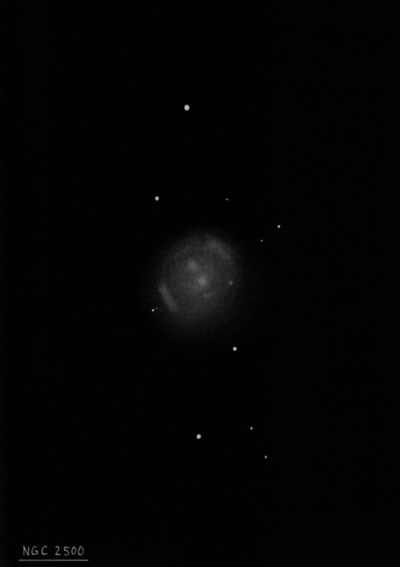
William Herschel discovered NGC 2500 = H III-709 = h478 on 9 Mar 1788 (sweep 815) and recorded "vF, R, vgbM; about 2 1/2 minutes in diameter." A later observation says "I can perceive some of the stars." This is a mottled face-on spiral, so this created the impression of resolving some stars.
On 1 Feb 1851, Lord Rosse "saw stars in it and suspected at one time a curvilinear arrangement. On later observations spiral structure was suspected and sketches (by R.J. Mitchell and Samuel Hunter) reasonably capture the spiral structure, although they were not certain. In addition a couple of HII knots on the preceding side were apparently noticed.
300/350mm - 13.1" (2/23/85): moderately bright, fairly large, almost round, mottled, weak concentration. Situated midway between a mag 12 star 1.9' NE and a mag 10.5 star 1.7' SW of center.
Notes by Steve Gottlieb
NGC 2776
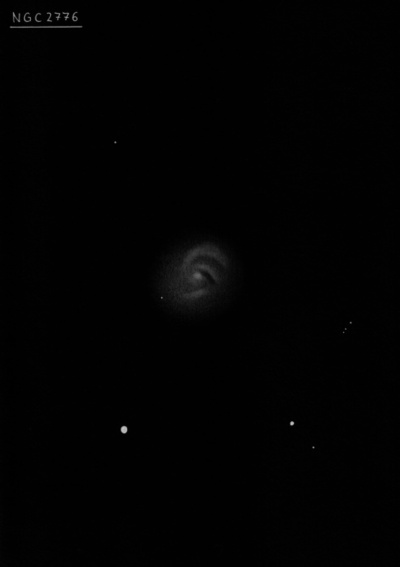
John Herschel discovered NGC 2776 = h563 on 19 Mar 1828 (sweep 139) and described "pB; vL; R; vgbM; resolvable; 3' diam." His position is accurate. R.J. Mitchell, the 72" observer on 16 Feb 1858, noted "pL, mottled and suspect spiral.".
200/250mm - 8" faint, moderately large, 1.5' diameter, slightly elongated ~N-S, weak concentration. Located 8' NE of mag 7.5 SAO 42735.
400/500mm - 17.5" (3/16/96): moderately bright, moderately large, 1.5' diameter, round. Fairly even concentration with a large 1' core increasing to a 20" nucleus. A mag 11 star is 4' SSE. Located 9' NE of mag 7.6 SAO 42735.
Notes by Steve Gottlieb
NGC 2782
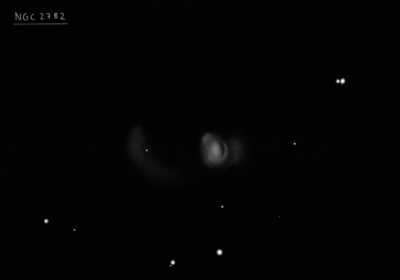
William Herschel discovered NGC 2782 = H I-167 = h568 on 18 Mar 1787 (sweep 716) and recorded, "cB, R, BN, about 1.5' dia." His position is 1.5' south of UGC 4862 = Arp 215. Using the 72", Ralph Copeland described the galaxy as "B, pL, R, irregular, pgsmbMN." John Herschel made a single observation on 18 Mar 1831, but recorded no description.
Arp 215 is the result of a very unequal mass merger between two galaxies and contains extremely faint tidal tails.
200/250mm - 8" faint, bright core, two mag 13 stars to the S, mag 9 star 5' N.
400/500mm - 17.5" moderately bright, fairly small, slightly elongated, sharp concentration, stellar nucleus, slightly elongated fainter halo. A pair of mag 13 stars are 3' S and mag 9 SAO 42762 is 8.5' NNE.
Notes by Steve Gottlieb
NGC 2549
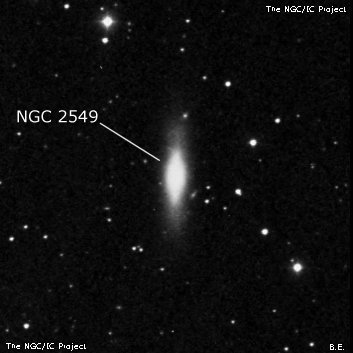
John Herschel discovered NGC 2549 = h495 on 9 Feb 1831 (sweep 323) and recorded "pB; S; mE; pos in merid; psmbM; 15" l, 6" br. A *7m follows." His position and description matches UGC 4313.
300/350mm - 13.1" (1/18/85): fairly bright, fairly small, edge-on 4:1 N-S, 2.0'x0.5', very bright core, stellar or almost stellar nucleus. Located 10' WNW of mag 5.9 30 Lyncis.
Notes by Steve Gottlieb
NGC 2832
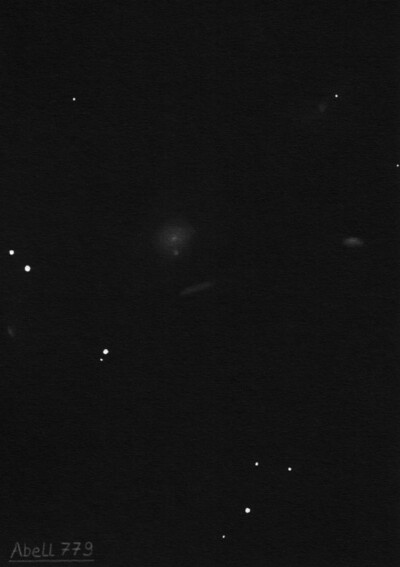
William Herschel discovered NGC 2832 = H I-113 = h582 on 7 Dec 1785 (sweep 487) and recorded "cB, much brighter following the middle, pL. North of 3 stars in a row at very unequal distances, iF." On 22 Jan 1827 (sweep 51), John Herschel wrote, "B; R; bM." Due to a confusion with the sketch of the cluster made in 1851 at Birr Castle, Dreyer assigned H I-113 to nearby NGC 2830, a much fainter galaxy. See Corwin's notes for full story.
300/350mm - 13.1" (1/28/84): fairly faint, fairly small, round. This object is the central galaxy in AGC 779.
400/500mm - 17.5" (1/31/87): moderately bright, fairly small, round bright core, slightly elongated halo. This is the brightest galaxy in AGC 779 and forms a double system with NGC 2831 at the SW edge of halo 22" between centers. Also nearby is NGC 2830 1.3' SW. A double star h2493 = 10.1/11.7 is 2.5' SSE and a wide mag 11/12.5 pair is 3.0' ESE.
Notes by Steve Gottlieb
NGC 2798
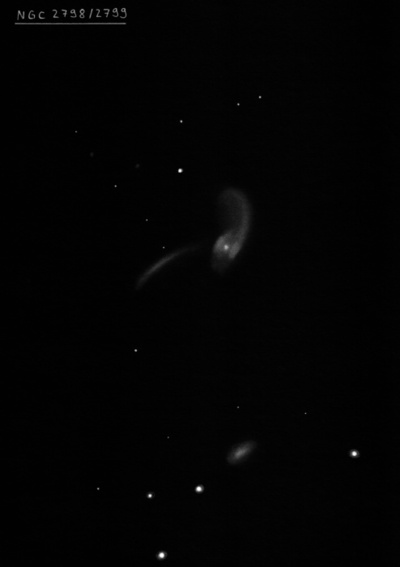
William Herschel discovered NGC 2798 = H II-708 on 14 Jan 1788 (sweep 797) and noted "pB, S, stellar." His position is 3.5' too far southeast. Nearby NGC 2799 was first seen at Birr Castle.
400/500mm - 17.5" (4/6/91): fairly faint, small, slightly elongated, very small bright core, stellar nucleus. A mag 14 star is 1.6' NNE of center. Forms a double system (interacting) with NGC 2799 1.5' ESE.
600/800mm - 24" (3/9/13): fairly bright, fairly large, elongated 5:2 NW-SE, 1.7'x0.7', fairly sharply concentrated with a very bright core that increases to a small, intense nucleus. The extension (spiral arm) to the northwest is brighter. Forms a striking double system (Arp 283) with NGC 2799 1.5' ESE. UGC 4904 lies 5' S and appears as a fairly faint glow, slightly elongated NW-SE, 25"x20", weak concentration. The trio forms KTG 22.
900/1200mm - 48" (4/6/13): very bright, large, elongated 2:1 NNW-SSE, 2.0'x1.0'. Sharply concentrated with a very bright, large core increasing to a small, intense nucleus. A very large spiral arm extends to the NNW from the core and curves back sharply at the end counterclockwise to the SSE, fading rapidly to a very low surface brightness and dimmng out before reaching the core. The SSE extension has an extremely low surface brightness and no arm structure was visible. Forms an interacting pair with NGC 2799 1.5' ESE.
Notes by Steve Gottlieb
UGC 3828
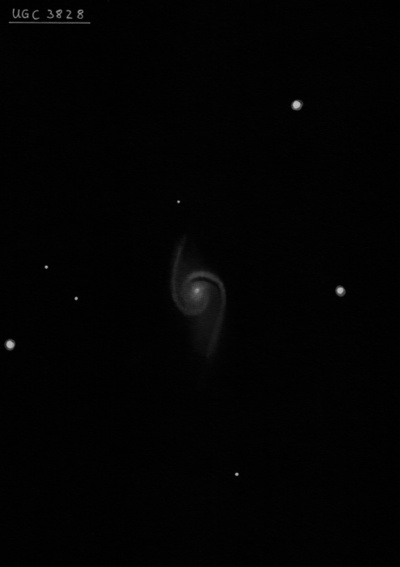
400/500mm - 17.5" (3/1/03): fairly faint, fairly small, slightly elongated N-S, 1.0'x0.8', small bright core. Surprisingly bright for a UGC galaxy! In the same field is UGC 3816 12.5' NW.
Notes by Steve Gottlieb
NGC 2469
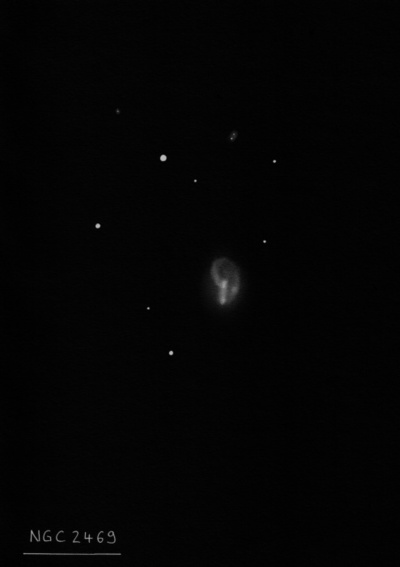
William Herschel discovered NGC 2469 = H III-836 = h470 on 18 Mar 1790 (sweep 949) and recorded "vF, vS, may be a patch of stars." His position is 12 seconds of time west of UGC 4111 = PGC 22327. On 9 Feb 1831 (sweep 323), John Herschel wrote, "pF; R; 15"; np a *9m which is 2 diameters of neb dist from its centre." The description is good except the star is northeast. MCG does label PGC 22327 as NGC 2469. See Corwin's notes for identification problems on other members of this group.
400/500mm - 17.5" (1/19/91): fairly faint, small, oval 3:2 NNW-SSE. A mag 14.5 star is off the NW end 0.8' from center. Third of three on a line with NGC 2472 6' E.
600/800mm - 24" (1/25/14): at 375x appeared moderately bright to fairly bright, fairly small, elongated 4:3 NNW-SSE, 36"x28", slightly brighter core, appears mottled. Located 2.3' SSW of a mag 9.5 star. 5th of 6 galaxies in a 25' E-W string.
Notes by Steve Gottlieb
NGC 2534
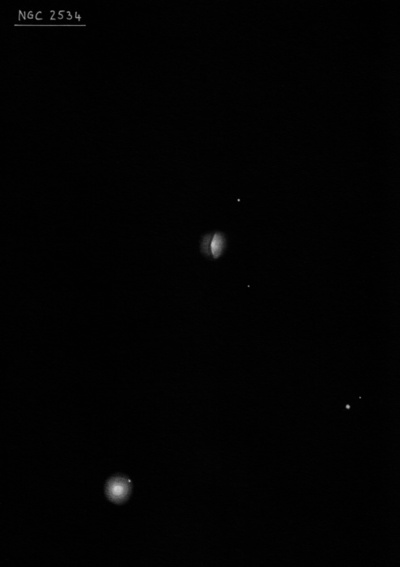
William Herschel discovered NGC 2534 = H III-840 = h490 on 18 Mar 1790 (sweep 949) and noted "cF, cS." His position, based on Caroline's reduction was just 1.6' too far northwest (typical error), though Auwers' reduced position is 9' S of UGC 4268 (an offset shared by several objects discovered on this sweep including NGC 2469, 2488, 2497 and 2505). On 10 Feb 1831 (sweep 324) John Herschel wrote, "pB; L; R; psbM; diam 60" and very gradually fading away; has a *8m pos = 164.3°.
R.J. Mitchell, observing on 7 Mar 1885 with Lord Rosse's 72" described "Has r[esolved] look, * plain at north end. Alpha [from sketch] is a knot or star. Neb is bM and probably spiral. Certainly a dark space from south-preceding to north." Spiral structure is not evident on the DSS.
400/500mm - 17.5" (1/19/91): fairly faint, small, round, broadly concentrated halo, faint stellar nucleus. A mag 15 star is 1' N. Located 2' N of mag 8.0 SAO 26726.
Notes by Steve Gottlieb
NGC 2793

John Herschel discovered NGC 2793 = h572 on 6 Mar 1828 (sweep 128) and reported, "vF; R; has a double star 5' north; 1 sec preceding." His position and description matches the ring galaxy UGC 4893.
300/350mm - 13.1" (1/28/84): very faint, fairly small, round, 0.8' diameter, low even surface brightness. Located 53' W of Alpha Lyncis (V = 3.1).
900/1200mm - 48" (4/4/11): 375x and 488x provided a fascinating view of NGC 2793, a collisional ring galaxy. It appeared as a fairly faint, moderately large roundish glow, ~0.8' diameter, with a well defined edge. The rim was slightly brighter along the north side, giving a partial annular or ring-like appearance [the SDSS image resolves this brighter rim into a series of small HII knots or star-forming regions. The likely companion galaxy or intruder is visible along the east side of the rim as a fairly bright small glow of high surface brightness, elongated 2:1 N-S, ~15"x8", mottled appearance. The actual nucleus of the ring galaxy is perhaps situated at the north end of the disrupting galaxy. A 15" pair of mag 10 stars (h2491) lies 5' N. NGC 2793 is located 8' WNW of mag 9.7 PPM 74387.
LEDA 82356 = 2MASX J09164092+3426511, a background galaxy, is located just 1.7' NW. It appeared faint, small, round, ~15" diameter, low even surface brightness.
Notes by Steve Gottlieb
NGC 2719
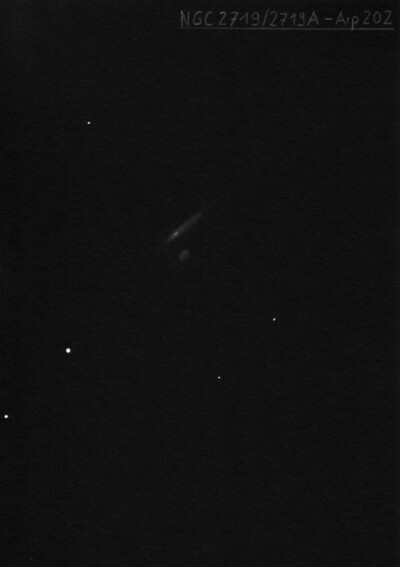
William Herschel discovered NGC 2719 = H III-540 = h541 on 28 Mar 1786 (sweep 549) and recorded "vF, S, lE, seems to contain 2 vF stars." His position is 11 seconds of RA too far west, but the description is accurate. On a second sweep he apparently added "E 20 degrees np-sf." and this implies the south-following star is certainly NGC 2719A. John Herschel made a single observation (interrupted by clouds) on 11 Mar 1831 (sweep 331).
400/500mm - 17.5" (3/20/93): faint, fairly small, very elongated 3:1 NW-SE. Forms a double system with NGC 2719A, which appears as a small knot at the south end, just 26" between centers. NGC 2724 lies 10' ENE.
600/800mm - 24" (2/24/20): at 260x; fairly faint, fairly small, elongated 5:2 NW-SE, 30"x12". NGC 2719 is nearly attached (barely resolved) just south of the SE end. It appeared as a very faint, small knot with a low surface brightness, 12"-15" diameter.
Notes by Steve Gottlieb
NGC 2444
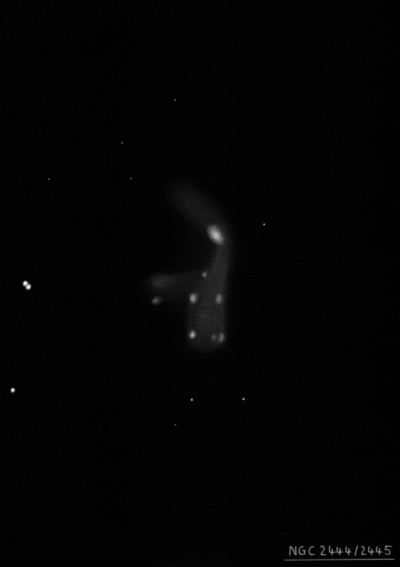
Édouard Stephan discovered NGC 2444 = St VIIIb-22 on 18 Jan 1877, along with NGC 2445. His position matches the northwest component of UGC 4016.
300/350mm - 13.1" (1/18/85): forms an interacting double ring system with NGC 2445. Both appear as two nearly stellar knots oriented NNW (NGC 2444) and SSE NGC 2445) with a separation of 1.0', surrounded by faint halo which may merge.
900/1200mm - 48" (4/5/13): NGC 2444 is the northwest component of a remarkable interacting system with the multi-component ring galaxy NGC 2445. At 488x it appeared bright, small, slightly elongated, 30" diameter, sharply concentrated with a very high surface brightness nucleus ~12"-15" diameter. NGC 2445, directly southeast has 6 components, the nearest being VV 117b, just 0.6' SSE.
Notes by Steve Gottlieb
UGC 3445
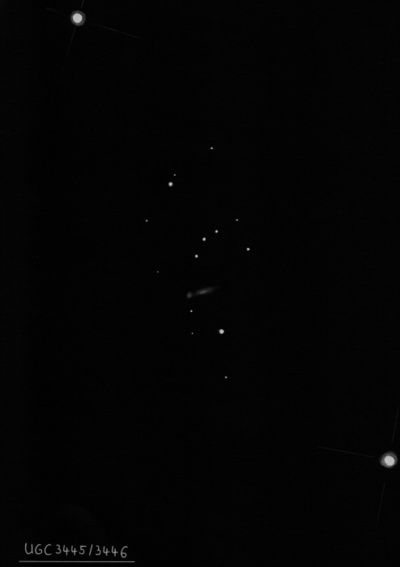
400/500mm - 17.5" (3/8/97): preceding member of a double system with similar UGC 3446, 43" separation between centers. Fairly faint, small, slightly elongated E-W, 30"x20" (only core viewed), moderate concentration with a very small fairly prominent nucleus. A mag 12.5 star lies 1' S which is part of a long string heading to the NE. Located 2' NE of a mag 10 star. Picked up while searching for IC 2166 located 1 degree east.
Notes by Steve Gottlieb
NGC 2429
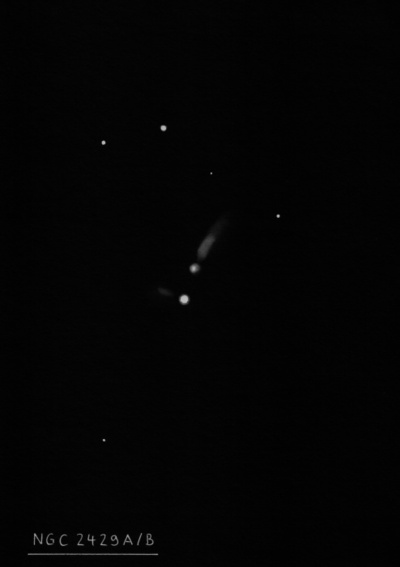
Ralph Copeland discovered NGC 2429 on 10 Mar 1874 with the 72". and recorded "pF, pS, vmE 146.4°, att to a *12 at sf end." Copeland's description and micrometric offset from a mag 10 star matches the double system UGC 3983. MCG lists the two components separately: MCG +09-13-039 = NGC 2429A and MCG +09-13-040 = NGC 2429B.
400/500mm - 17.5" (2/8/91): faint, small, very elongated 4:1 NW-SE, low even surface brightness. A mag 13.5 star is involved at the SE end 0.3' from center and a mag 11 star is 0.8' SE. Forms a pair with NGC 2426 5.0' SW.
Notes by Steve Gottlieb
UGC 4653
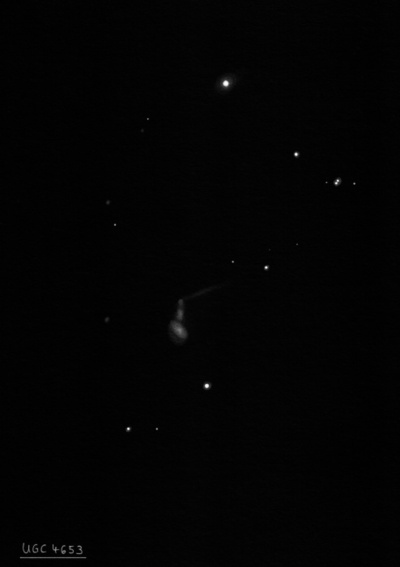
600/800mm - 24" (3/22/14): this interacting system was observed at 375x. The main component is on the south end (VV 243a = UGC 4653 NED1) appeared fairly faint, fairly small, elongated 5:3 SW-NE, ~0.5'x0.3', irregular shape. A very close companion (VV 243b = UGC 4653 NED2) is attached at the north edge [17" between centers] and appeared faint, very small, round, 15". The small companion and plume attached on its north side (VV 243c = UGC 4653 NED3) was not seen. Located 1.6' NNE of a mag 10 star.
900/1200mm - 48" (2/28/19): this interacting triple was viewed at 813x. The southern VV 243A component appeared moderately bright, fairly small, elongated 2:1 SW-NE, 30"x15", small brighter elongated core and stellar nucleus. The middle VV 243B section was attached at the north end and it appeared moderately bright, very elongated 3:1 or 4:1 N-S, ~30"x10", knotty but fairly low surface brightness. The nucleus of the northern "C" galaxy at the north tip of VV 243B was not separately resolved nor was the unusually long tidal tail (or background galaxy?) extending W. Located 1.5' NNE of a mag 9.9 star and 5' SSE of a mag 9.2 star.
LEDA 2060142, situated just 1.5' E, appeared fairly faint (V = 16.4), very small, round, 10" diameter, faint stellar nucleus. Easily visible with direct vision..
Notes by Steve Gottlieb
UGC 4051
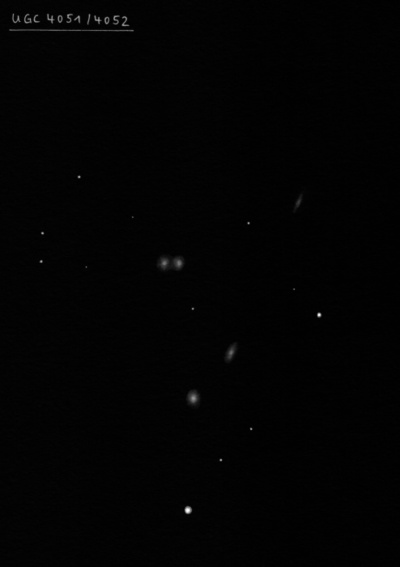
600/800mm - 24" (2/18/20): at 375x;, fairly faint, small, elongated 4:3 ~N-S, ~24"x18", brighter nucleus. Ina quartet with CGCG 236-005 1.1' NW and UGC 4052 (double system) 3.4' N.
Notes by Steve Gottlieb
UGC 4881
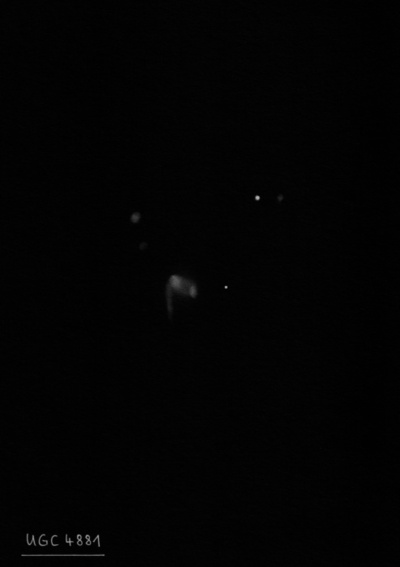
400/500mm - 18" (3/13/10): faint, fairly small, slightly elongated E-W, 0.5'x0.4'. While viewing this interacting pair of disrupted galaxies (Arp 55), I occasionally noticed an extension (companion galaxy) or knot at the west edge. A couple of times it appeared resolved from the main glow as an extremely faint and small glow. Located 5' NNE of mag 9.4 HD 79466.
900/1200mm - 48" (4/6/13): Arp 55 = "Grasshopper" is a merger of two galaxies with a single tidal tail on the east side. At 488x it appeared bright, moderately large, very unusual appearance with a mottled main body elongated 2:1 SW-NE, ~30"x15". On the southwest end is Arp 55S = PGC 3098124, a nearly stellar knot that is the nucleus of a merging, interacting companion. A faint, thin "arm" or "tail" is attached at the NE end and extends ~20"x5" straight south. The tail brightens slightly (perhaps an HII knot or another merged galaxy) at the south end. This knot has the designation SDSS J091556.72+441937.5. On the SDSS the tail curves sharply west on the south end, but this extension was not seen. A mag 16.2 star is 45" W.
SDSS J091559.93+442034.6 = LEDA 2242096 lies 0.9' NE and appeared as a very faint (V = 17.1), very low surface brightness patch, 15" diameter. Arp called this object a "filament" of Arp 55 in his 1967 paper "Peculiar Galaxies and Radio Sources" (ApJ, 148, 321). LEDA 82353 is 1.4' NE and appeared fairly faint, fairly small, slightly elongated E-W, 20"x15". LEDA 2242434 lies 2.3' NW, just 27" W of a mag 14.7 star. It appeared fairly faint, fairly small, slightly elongated E-W, 20"x15". These three galaxies have a identical redshifts as Arp 55, so are part of a small group.
Notes by Steve Gottlieb
PuWe 1
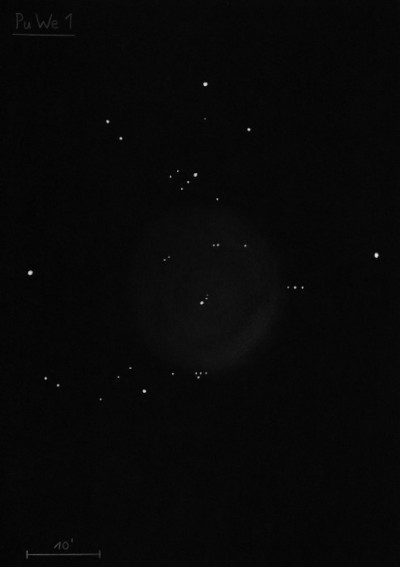
| Type | PN |
| RA | 06:19:33.9 |
| Dec | +55:36:44.0 |
| major_axis | 20.0' |
| mag | 11.2 |
| surface_bright | 17.5 |
HCG 35
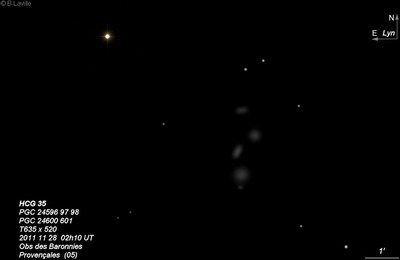
| Type | GALCL [S3] |
| RA | 08:45:19.6 |
| Dec | +44:31:18.0 |
| major_axis | 2.9' |
| mag | 12.4 |
| surface_bright | 99.9 |
Abell 16
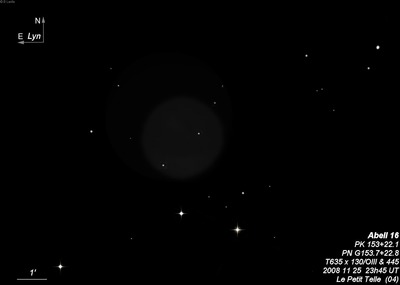
| Type | PN [2b] |
| RA | 06:43:55.5 |
| Dec | +61:47:25.0 |
| major_axis | 2.29' |
| mag | 15.9 |
| surface_bright | 17.5 |